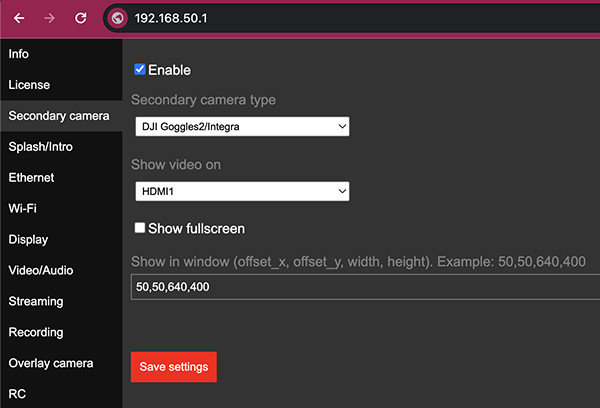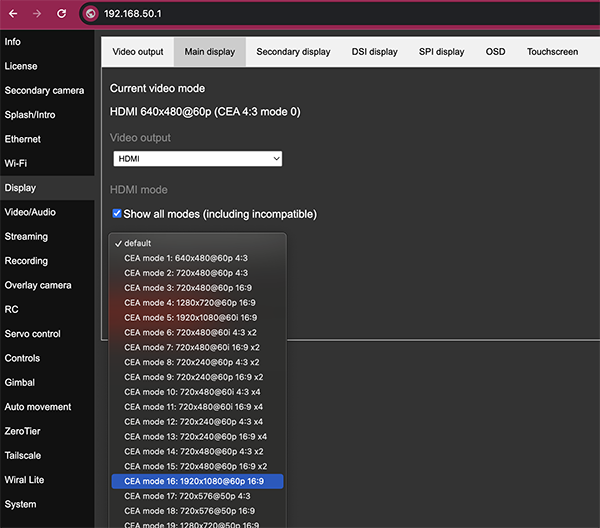Cosmostreamer for DJI FPV Goggles V1/V2
Product page
https://cosmostreamer.com/products/djifpvgoggles/
Supported Goggles
- DJI FPV Goggles V1 (max output resolution 720@60p)
- DJI FPV Goggles V2 (max output resolution 810@60p)
Supported Air Units and drones
If goggles can be paired with a drone or air unit and shows video - the same video will be available in Cosmostreamer.
- DJI O3 air unit
- DJI air unit (old)
- Caddx Vista (all models)
- DJI FPV drone
- DJI Avata
Hardware
Cosmostreamer for DJI FPV Goggles V1/V2 can work on these boards:
Raspberry Pi 4B
Any RAM size. 1Gb, 2Gb, 4Gb, 8Gb.
- Two micro-HDMI outs
- Analog video out (CVBS, TV-out) in 3.5 mini-jack
- DSI display may be used. If DSI display connected - only HDMI-0 may be used.
- Wi-Fi 2.4/5 GHz
- Ethernet 10/100/1000 Mbit/s
- 2 USB 2.0 ports + 2 USB 3.0 ports
- 1 USB-C port (can be used as power input)
Raspberry Pi 3B/3B+
- HDMI port
- Analog video out (CVBS, TV-out) in 3.5 mini-jack
- DSI display may be used. If DSI display connected - HDMI can't be used.
- Wi-Fi 2.4 GHz (RPI 3B) or 2.4/5 GHz (RPI 3B+)
- Ethernet 10/100/1000 Mbit/s
- 4 USB 2.0 ports
- 1 micro-USB port for power in
Raspberry Pi Zero/ZeroW
Not supported due slow CPU
Raspberry Pi Zero2W
- Mini-HDMI port
- Wi-Fi 2.4GHz/5GHz
- Micro-USB port for power in
Installing the Cosmostreamer firmware
- Get a blank microSD card of 8GB or larger. Insert the microSD card into the card reader
- Download ZIP-archive with firmware content
- Extract .img file from downloaded ZIP archive
- Use Win32DiskImager on Windows or Balena Etcher on Mac and write .img file on microSD card
- Insert the microSD card into the Raspberry Pi
- If you have a monitor or a TV with HDMI input - plug it to the Raspberry Pi HDMI port (if Rpi 4B is used - HDMI-0 port, nearest to USB-C port)
- Plug a standard USB power supply or powerbank to the Raspberry Pi (go to chapter Power for Raspberry Pi). Raspberry Pi must start booting. A couple of reboots may be during the first boot
Power for Raspberry Pi
Power with standard Micro-USB or USB-C port
USB-C port on Raspberry Pi 4, micro-USB port on Raspberry Pi 3 B/B+/Zero/ZeroW/Zero2W
Power with GPIO (pins)
Use any USB cable, need to cut it and connect to the RPI only 2 wires - Red (5V) and Black (Gnd). Then you can use it with any standard USB power supply or powerbank.
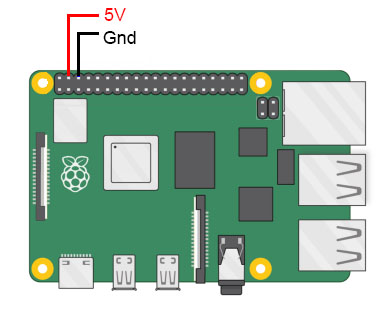
Power with PoE
Only for Raspberry Pi 4B and 3B+. Need to use PoE Hat.
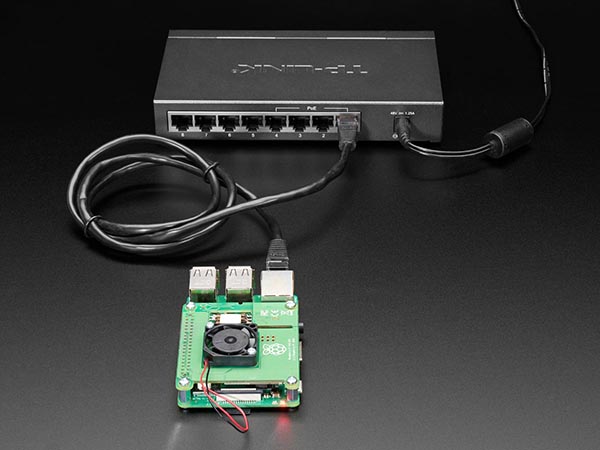
Network connection
Ethernet
Only for Raspberry Pi versions with Ethernet port. Connect Ethernet cable to the Raspberry Pi Ethernet port at one side and home router or PC/Mac Ethernet port on another side
Wi-Fi
Connect your PC/Mac or smartphone to Wi-Fi network cosmostreamer, password 1234512345
Settings and controls
Browser In Wi-Fi Access Point mode
Also you could open Cosmostreamer web admin page in browser
http://192.168.50.1
http://my.cosmostreamer.com
Then click "Device settings" in menu shown by click on Menu icon in right bottom corner.
Browser in WLAN client mode
Open in browser http://cosmostreamer.local
This is dynamical host name so may not work properly if multiple Cosmostreamer devices in the same network or IP changes.
Then click "Device settings" in menu shown by click on Menu icon in right bottom corner.
Windows application
Download, install and run CosmoViewerNG application.
Mac application
Download, install and run CosmoViewerNG application
Firmware update
- Run CosmoViewerNG for Win or for Mac or open web page and then open device settings, chapter "System"
- Download the Latest firmware update file
- Choose downloaded update file (with .csuf extension) in "Firmware update" field and press "Upload file" button
- Raspberry Pi must goes to reboot automatically after update installed
Changing camera type
In Cosmostreamer system terminology, a camera is any device that Cosmostreamer can work with. DJI Pocket, DJI Osmo, Goggles - this all a "camera".
MicroSD image with Cosmostreamer configured for "DJI Goggles2/Integra" by default, so need to change a "camera type" for using with DJI Goggles V1/V2.
- Open device settings in CosmoViewerNG application or in web interface
- Go to chapter "Info"
- Choose camera type "DJI FPV Goggles V1/V2"
- Disable option "Allow auto detection" if enabled
- Don't forget to click "Save" button.
License key
License key is a text string, unique for each Raspberry Pi. Each camera type needs different license keys. It's possible to install multiple amount of license keys on one device and use this device for some camera types, i.e. Pocket Osmo, Pocket 2, and others. Need to buy license for correct operation process.
- Buy license key on a product page
- Make a photo of HDMI display or screenshot of the app with a QR image and send it in email on cosmostreamer@gmail.com for making a license key
- When you got a license key - use web interface or CosmoViewerNG application, menu "device settings" -> "License" and insert license key into field. And click "Install license" button.
DJI FPV Goggles V1/V2 connection
Use any standard USB-C cable and plug it into any of four USB-A ports on Raspberry Pi.
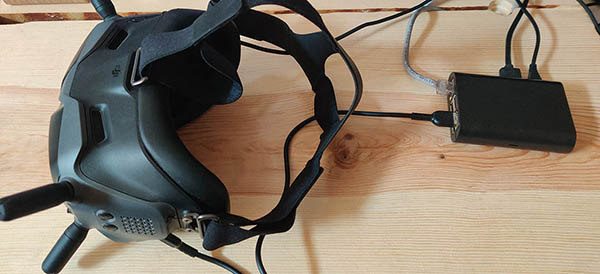
Collaboration with DJI Goggles2/Integra
Exclusive mode
In a case of using Raspberry Pi 4 it is possible to use both types, V1/V2 and Goggles2/Integra, without a manual changing a "camera type".
Both licenses, for "DJI FPV Goggles V1/V2" and for "DJI Goggles2/Integra" must be already installed!
- Open device settings in CosmoViewerNG application or in web interface
- Go to chapter "Info"
- Choose camera type "DJI Goggles2/Integra" or "DJI FPV Goggles V1/V2"
- Enable option "Allow auto detection"
- Don't forget to click "Save" button.
Now Cosmostreamer will cyclically run one and another apps and if one type of Goggles is plugged - it will be used for video capture. Another goggles will be ignored.
Cooperative mode
Both DJI Goggles2/Integra and DJI FPV Goggles V1/V2 can work at the same time.
Both licenses, for "DJI FPV Goggles V1/V2" and for "DJI Goggles2/Integra" must be already installed!
- Open web admin page or run CosmoViewerNG application
- Open device settings
- Go to chapter "Info"
- Disable option "Allow auto detection"
- Go to chapter "Secondary camera"
- Choose "Secondary camera type" "DJI Goggles2/Integra"
- Choose where to show video, on HDMI-0 port, on HDMI-1 port or on DSI display
- If you want to show video fullscreen - enable option "Show fullscreen"
- If you want to show video in window - enter window params in format X, Y, W, H where X - horizontal offset from the left display side, Y - vertical offset from the top display side, W - window width, H - window height. For example: 50,50,640,400
- Click "Save" button
HDMI modes
Since one of the main use cases of the Cosmostreamer is video output via HDMI, it is useful to be able to set the HDMI output to the desired mode.
When HDMI cable is plugged to the Raspberry Pi before power on, default HDMI mode will be choosed during initial handshake between Raspberry Pi and HDMI display. Usually it is the maximal HDMI display resolution and framerate. If no HDMI cable plugged when Raspberry Pi powered on - default resolution 640x480 will be enabled and does not changed if HDMI display will be plugged. This resolution can be overrided in Cosmostreamer settings.
For Raspberry Pi4: HDMI mode setting is available only for HDMI-0 port!
- Open Device settings
- Go to chater "Display"
- Open tab "Main display"
- Check video output is "HDMI"
- Set needed HDMI mode. This mode will be used even if no HDMI cable is plugged before Raspberry Pi powered on.
Downloads
FAQ
Which goggles version is supported?
DJI FPV Goggles V1 and V2
Does it works with DJI Goggles2 or Integra?
No, need to use another camera type "DJI Goggles2/Integra" (product page) with another license key
Can I just unplug the power cable from the box?
Yes, the file system on the microSD is in read-only mode, so you can unplug the power cable without any problem
